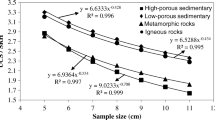Abstract
Uniaxial compressive strength is considered one of the most important parameters in the characterization of rock material in rock engineering practice. The study investigated correlations between uniaxial compressive strength and point load index, P-wave velocity and Schmidt hardness rebound number together with the effects of core diameter size. A total of 150 core samples at five different diameters (54, 48, 42, 30 and 21 mm) were obtained from sandstone, limestone and cement mortar. Ten saturated samples at each diameter (length:diameter ratio 2:1) were prepared from each of the three materials. The best correlations were found between uniaxial compressive strength and point load or Schmidt hammer values. The closest relationship was observed for the 48 mm diameter cores.
Résumé
La résistance à la compression simple est considérée comme l’un des paramètres les plus importants pour caractériser la résistance de la matrice rocheuse dans les applications de la mécanique des roches. L’étude s’est intéressée aux corrélations entre la résistance à la compression simple et l’indice d’écrasement entre pointes, la vitesse des ondes P et l’indice de rebond au marteau de Schmidt, considérant de plus l’influence du diamètre des carottes testées. Au total, 150 échantillons de grès, calcaires et mortiers de ciment, dans cinq diamètres différents (54, 48, 42, 30 et 21 mm) ont été préparés. Dix échantillons saturés ont été testés pour les trois types de roche et pour chaque diamètre (ratio longueur/diamètre = 2/1). Les meilleures corrélations ont été trouvées entre la résistance à la compression simple et la résistance entre pointes ou l’indice de rebond de Schmidt. Les relations les plus précises ont été obtenues pour les échantillons de diamètre 48 mm.










Similar content being viewed by others
References
Al Jassar SH, Hawkins AB (1979) Geotechnical properties of the Carboniferous Limestone of the Bristol area—the influence of petrography and chemistry. In: 4th ISRM Conference, Montreaux, vol 1, pp 3–14
ASTM (1984) American Society for testing and materials. Standard test method for unconfined compressive strength of intact rock core specimens. Soil and Rock, Building Stones: Annual Book of ASTM Standards, vol 4.08, Philadelphia, Pennsylvania
Bieniawski ZT (1975) Point load test in geotechnical practice. Eng Geol 1:1–11
Broch EM, Franklin JA (1972) The point load strength test. Int J Rock Mech Min Sci Geomech Abstr 9:669–697
D’Andrea DV, Fischer RL, Fogelson DE (1965) Prediction of compressive strength from other rock properties. US Bureau of Mines Report of Investigations 6702
Entwisle DC, Hobbs PRN, Jones LD, Gunn D, Raines MG (2005) The relation between effective porosity, uniaxial compressive strength and sonic velocity of intact Borrowdale Volcanic Group core samples from Sellafield. Geotechn Geol Eng 23:793–809
Forster IR (1983) The influence of core sample geometry on the axial point load test. Int Rock Mech Min Sci 20:291–295
Ghosh DK, Srivastava M (1991) Point-load strength: an index for classification of rock material. Bull Int Assoc Eng Geol 44:27–33
Göktan RM (1988) Theoretical and practical analysis of rock rippability. PhD Thesis, Istanbul Technical University
Hassani FP, Scoble MJ, Whittacker BN (1980) Application of the point load index test to strength determination of rock and proposals for a new size correction chart. In: Proc 21st US Symp. Rock Mech., Rolla, pp 543–553
Hawkins AB (1998) Aspects of rock strength. Bull Eng Geol Env 57:17–30
Hawkins AB, Olver JAG (1986) Point load tests: correlation factor and contractual use. An example from the Corallian at Weymouth In: Hawkins AB (ed) Site Investigation Practice: Assessing BS 5930, Geological Society, London, pp 269–271
Hoek E, Brown ET (1980) Underground excavations in rock. Inst Min Metal, London
ISRM (1981) Rock characterization, testing and monitoring, ISRM suggested methods. Pergamon, Oxford, 211 p
Kahraman S (2001) Evaluation of simple methods for assessing the uniaxial compressive strength of rock. Int J Rock Mech Min Sci 38:981–994
Katz O, Reches Z, Roegiers JC (2000) Evaluation of mechanical rock properties using a Schmidt hammer. Tech Note Int J Rock Mech Min Sci 37:723–728
Norbury DR (1986) The point load test. In: Hawkins AB (ed) Site investigation practice: assessing BS 5930, Geological Society, pp 325–329
O’Rourke JE (1989) Rock index properties for geo-engineering in underground development. Min Eng 41:106–110
Palchik V, Hatzor YH (2004) The influence of porosity on tensile and compressive strength of porous chalks. Rock Mech Rock Eng 37(4):331–341
Pells PJN (1975) The use of the point load test in predicting the compressive strength of rock materials, Aust Geomech J G5, pp 54–56
Romana M (1999) Correlation between uniaxial compressive and point load (Franklin test) strengths for different rock classes. In: 9th ISRM Congress, 1999, vol 1, pp 673–676, Paris
Sachpazis CI (1990) Correlating Schmidt hammer rebound number with compressive strength and Young’s modulus of carbonate rocks. Bull Int Assoc Eng Geol 42:75–83
Singh RN, Hassani FP, Elkington PAS (1983) The application of strength and deformation index testing to the stability assessment of Coal Measures excavations. In: Proceedings of 24th US symposium on rock mechanics, Texas A&M Univ, AEG, pp 599–609
Thuro K, Plinninger RJ (2005) Scale effects in rock properties: Part 2. Point load test and point load strength index. EUROCK Swets and Zeitlinger, pp 175–180, Lisse
Tsiambaos G, Sabatakakis N (2004) Considerations on strength of intact sedimentary rocks. Eng Geol 72:261–273
Wiesner E, Gillate SJ (1997) An evaluation of the relationship between unconfined compressive strength and point load strength index. Bull Int Assoc Eng Geol 56:115–118
Yaşar E, Erdoğan Y (2004) Estimation of rock physicomechanical properties using hardness methods. Eng Geol 71:281–288
Author information
Authors and Affiliations
Corresponding author
Rights and permissions
About this article
Cite this article
Çobanoğlu, İ., Çelik, S.B. Estimation of uniaxial compressive strength from point load strength, Schmidt hardness and P-wave velocity. Bull Eng Geol Environ 67, 491–498 (2008). https://doi.org/10.1007/s10064-008-0158-x
Received:
Accepted:
Published:
Issue Date:
DOI: https://doi.org/10.1007/s10064-008-0158-x
Keywords
- Uniaxial compressive strength
- Point load strength index
- Schmidt hammer rebound value
- Sonic wave velocity




